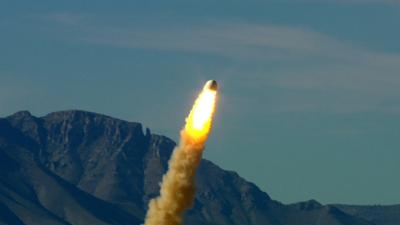Fri, Sep 09, 2016
Flight Planned For Early October
Jeff Bezos says the next flight of New Shepard is going to be dramatic, no matter how it ends.

Like Mercury, Apollo, and Soyuz, Blue Origin's New Shepard has an escape system that can quickly propel the crew capsule to safety if a problem is detected with the booster. But according to Bezos, the escape system is configured differently from those earlier designs. They mounted the escape motor on a tower above the capsule – a “tractor” configuration – the escape motor would pull the capsule away from a failing booster. But because a capsule cannot reenter Earth’s atmosphere or deploy parachutes with a tower on top, the tower, along with the escape motor, must be jettisoned on every flight – even the nominal flights. Expending an escape motor on every flight drives up costs significantly. Further, the jettison operation is itself safety critical. Failure to jettison the tower is catastrophic.
Bezos says the New Shepard escape motor pushes rather than pulls and is mounted underneath the capsule rather than on a tower. There is no jettison operation. On a nominal mission, the escape motor is not expended and can be flown again and again. We’ve already tested our pusher escape system (see image above), including many ground tests and a successful pad escape test, but this upcoming flight will be our toughest test yet. We’ll intentionally trigger an escape in flight and at the most stressing condition: maximum dynamic pressure through transonic velocities.
Capsule in-flight escape testing was last done during the Apollo program. From 1964-1966, in-flight escape tests were performed with Apollo simulator capsules using an expendable booster called the Little Joe II. We’ll be doing our in-flight escape test with the same reusable New Shepard booster that we’ve already flown four times. About 45 seconds after liftoff at about 16,000 feet, we’ll intentionally command escape. Redundant separation systems will sever the crew capsule from the booster at the same time we ignite the escape motor. The escape motor will vector thrust to steer the capsule to the side, out of the booster’s path. The high acceleration portion of the escape lasts less than two seconds, but by then the capsule will be hundreds of feet away and diverging quickly. It will traverse twice through transonic velocities – the most difficult control region – during the acceleration burn and subsequent deceleration. The capsule will then coast, stabilized by
reaction control thrusters, until it starts descending. Its three drogue parachutes will deploy near the top of its flight path, followed shortly thereafter by main parachutes.
What of the booster? It’s the first ever rocket booster to fly above the Karman line into space and then land vertically upon the Earth. And it’s done so multiple times. Bezos said he would really like to retire it after this test and put it in a museum. "Sadly, that’s not likely. This test will probably destroy the booster. The booster was never designed to survive an in-flight escape. The capsule escape motor will slam the booster with 70,000 pounds of off-axis force delivered by searing hot exhaust. The aerodynamic shape of the vehicle quickly changes from leading with the capsule to leading with the ring fin, and this all happens at maximum dynamic pressure.
"Nevertheless, the booster is very robust and our Monte Carlo simulations show there’s some chance we can fly through these disturbances and recover the booster," Bezos said. "If the booster does manage to survive this flight – its fifth – we will in fact reward it for its service with a retirement party and put it in a museum. In the more likely event that we end up sacrificing the booster in service of this test, it will still have most of its propellant on board at the time escape is triggered, and its impact with the desert floor will be most impressive."
Bezos said that the test should be in the first part of October, "and we’ll webcast it live for your viewing pleasure."
(Image provided with Blue Origin news release)
More News
Aero Linx: International Federation of Airworthiness (IFA) We aim to be the most internationally respected independent authority on the subject of Airworthiness. IFA uniquely combi>[...]
Ultrahigh Frequency (UHF) The frequency band between 300 and 3,000 MHz. The bank of radio frequencies used for military air/ground voice communications. In some instances this may >[...]
A Few Questions AND Answers To Help You Get MORE Out of ANN! 1) I forgot my password. How do I find it? 1) Easy... click here and give us your e-mail address--we'll send it to you >[...]
From 2019 (YouTube Edition): Learning To Paint Without Getting Any On Your Hands PPG's Aerospace Coatings Academy is a tool designed to teach everything one needs to know about all>[...]
Also: Sustainable Aircraft Test Put Aside, More Falcon 9 Ops, Wyoming ANG Rescue, Oreo Cookie Into Orbit Joby Aviation has reason to celebrate, recently completing its first full t>[...]
 ANN's Daily Aero-Linx (05.06.25)
ANN's Daily Aero-Linx (05.06.25) ANN's Daily Aero-Term (05.06.25): Ultrahigh Frequency (UHF)
ANN's Daily Aero-Term (05.06.25): Ultrahigh Frequency (UHF) ANN FAQ: Q&A 101
ANN FAQ: Q&A 101 Classic Aero-TV: Virtual Reality Painting--PPG Leverages Technology for Training
Classic Aero-TV: Virtual Reality Painting--PPG Leverages Technology for Training Airborne 05.02.25: Joby Crewed Milestone, Diamond Club, Canadian Pilot Insurance
Airborne 05.02.25: Joby Crewed Milestone, Diamond Club, Canadian Pilot Insurance



